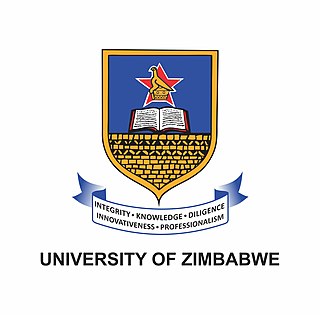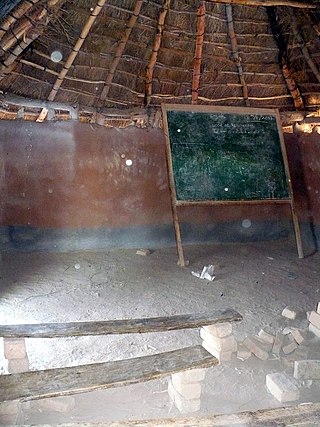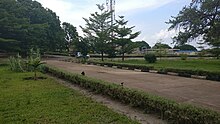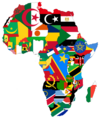
Zambia, officially the Republic of Zambia, is a landlocked country at the crossroads of Central, Southern and East Africa. It is typically referred to being in South-Central Africa or Southern Africa. It is bordered to the north by Democratic Republic of the Congo, Tanzania to the north-east, Malawi to the east, Mozambique to the southeast, Zimbabwe and Botswana to the south, Namibia to the southwest, and Angola to the west. The capital city of Zambia is Lusaka, located in the south-central part of Zambia. The population is concentrated mainly around Lusaka in the south and the Copperbelt Province to the north, the core economic hubs of the country.

The Zambian Defence Force is the military of Zambia. It consists of the Zambian Army, the Zambian Air Force, and the Zambia National Service. The defence forces were formed at Zambian independence on 24 October 1964, from constituent units of the dissolved Federation of Rhodesia and Nyasaland Armed Forces. During the 1970s and 1980s, it played a key role in a number of regional conflicts, namely the South African Border War and Rhodesian Bush War. Being a landlocked country Zambia has no navy, although the Zambian Army maintains a maritime patrol unit for maintaining security on inland bodies of water.

After independence in 1964 the foreign relations of Zambia were mostly focused on supporting liberation movements in other countries in Southern Africa, such as the African National Congress and SWAPO. During the Cold War Zambia was a member of the Non-Aligned Movement.

The University of Zimbabwe (UZ) is a public university in Harare, Zimbabwe. It opened in 1952 as the University College of Rhodesia and Nyasaland, and was initially affiliated with the University of London. It was later renamed the University of Rhodesia, and adopted its present name upon Zimbabwe's independence in 1980. UZ is the oldest university in Zimbabwe.

Kitwe is the third largest city in terms of infrastructure development and second largest city in terms of size and population in Zambia. With a population of 517,543 Kitwe is one of the most developed commercial and industrial areas in the nation, alongside Ndola and Lusaka. It has a complex of mines on its north-western and western edges.

Lower education in Zambia is divided into three levels and these are namely: primary, junior secondary and upper secondary. Higher education in Zambia has improved in the recent years due to the increase of private universities and colleges. The biggest university is the public University of Zambia which is located in the capital city of Lusaka along the great east road and hosts a number of local and international students. The Copperbelt University is the second largest public university and is located in the Copperbelt province of Zambia in Kitwe, and the youngest public university is Mulungushi University, with its main campus 26 km north of Kabwe. There are many other smaller universities, both public and private including the following: Texila American University, Zambia Open University, European University Zambia Zambia Catholic University, Cavendish University, Zambia Adventist University, Northrise University, University of Lusaka, Lusaka Apex Medical University, Woodlands University College, Copperstone University College, University of Barotseland, University of Africa, Information and Communication University, Kwame Nkrumah University of Education, Chalimbana University, Rusangu University, Robert Makasa University, Zambia Centre of Accountancy Studies and there are various Health training Institutes offering Diplomas in clinical medicine Registered Nursing

The following outline is provided as an overview of and topical guide to Zambia:

Lusaka is the capital and largest city of Zambia. It is one of the fastest-developing cities in southern Africa. Lusaka is in the southern part of the central plateau at an elevation of about 1,279 metres (4,196 ft). As of 2019, the city's population was about 3.3 million, while the urban population is estimated at 2.5 million in 2018. Lusaka is the centre of both commerce and government in Zambia and connects to the country's four main highways heading north, south, east, and west. English is the official language of the city administration, while Bemba, Tonga, Lenje, Soli, Lozi, and Nyanja are the commonly spoken street languages.
University of Lusaka (UNILUS) is a private university founded in 2007 in Lusaka, Zambia. It is a member of the Association of Commonwealth Universities.
The University of Zambia Library is the academic library of the University of Zambia (UNZA) in Lusaka, Zambia. It consists of three specialised libraries: the UNZA Main Library, the School of Veterinary Medicine Library, and the Medical Library. The main library was designated a National Reference Library and is as such open to the general public.
Cavendish University Zambia (CUZ) is a private university located in Lusaka, Zambia. It was opened in 2004 and is the first private university to operate in Zambia. The university is registered with the Higher Education Authority which is a grant aided institution established under the Higher Education Act No. 4 of 2013. Cavendish is also affiliated with the Association of African Universities (AAU).

The University of Zambia School of Medicine (UNZASOM), also known as University of Zambia Medical School is the school of medicine of the University of Zambia. The medical school is the country's first public medical school, the other being the Copperbelt University School of Medicine. The school provides medical education at undergraduate and postgraduate levels.
Kwame Nkrumah University (KNU) is a public university in Zambia.
Lusaka Apex Medical University is a private university in Zambia. It was established in 2008 and has continued to provide the most modern way of learning medicine in the country.
The Higher Education Authority (HEA) of Zambia was established under the Higher Education Act No. 4 of 2013 in order to provide quality assurance, regulation of private and public higher education institutions and registration of private higher education institutions.
The University of Zambia School of Public Health (UNZASPH), is one of the schools that comprise the University of Zambia College of Health Sciences.
An institutional repository (IR) is simply a "digital archive of the intellectual products created by faculty research staff and students of an institution and accessible to end users both within and outside of the institution, with few if any barriers to access”. To enhance optimization and accessibility of the content in the IR, open access repositories are registered with the Directory of Open Access Repositories (OpenDOAR) which basically is a list of open academic repositories. Many universities have established IRs to promote open access to knowledge and information. The University of Zambia Institutional Repository (UNZA-IR) was established in 2010 with the support of the Netherlands Government to help archive the intellectual output of the university. The repository falls under the UNZA main Library and is headed by the repository manager who oversees the operations of the repository. The UNZA repository was created using Dspace, an "open source repository software package used for creating open access repositories.




















